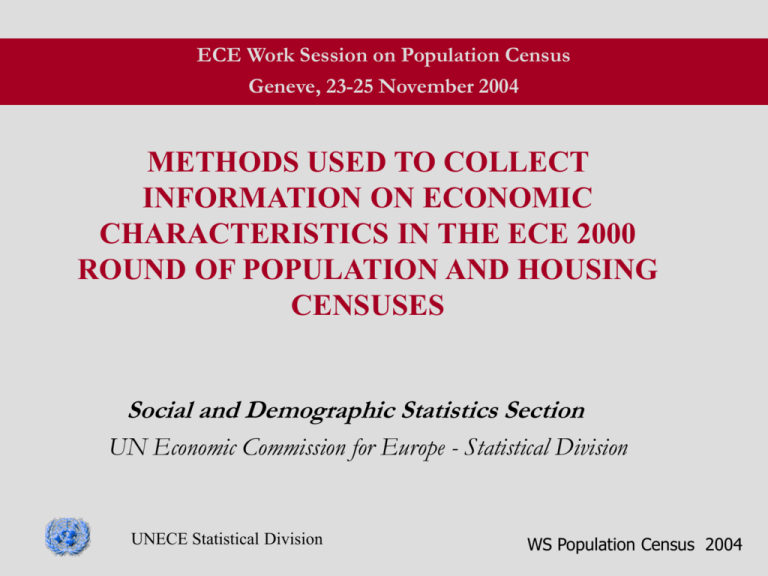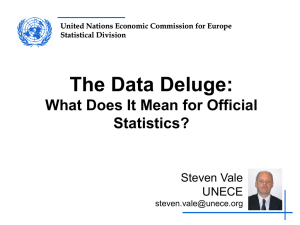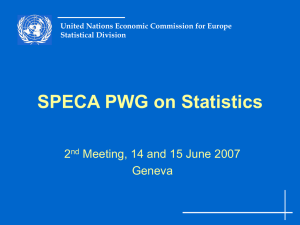Implications for the Revision of the ECE Recommendations
advertisement

ECE Work Session on Population Census Geneve, 23-25 November 2004 METHODS USED TO COLLECT INFORMATION ON ECONOMIC CHARACTERISTICS IN THE ECE 2000 ROUND OF POPULATION AND HOUSING CENSUSES Social and Demographic Statistics Section UN Economic Commission for Europe - Statistical Division UNECE Statistical Division WS Population Census 2004 Population Active Inactive Student Employed Pension or other Unemployed Housework Other UNECE Statistical Division WS Population Census 2004 A2. Do you work? A1. What is your activity status? A.3 Source of livelihood Entry Question Employed Unemployed UNECE Statistical Division Student Homework Pension WS Population Census 2004 Graph 1: Census M ethodologies 6 17 What is your current activity status? Did you w ork last w eek?/ Do you w ork? What are your sources of livelihood? 15 UNECE Statistical Division WS Population Census 2004 First Approach employee Employed Economic activity Unemploy ed employer . . Self-employed . . Contributing family worker… . Other (Not active) Economic activity UNECE Statistical Division Occupation Industry Economic activity Status in employment WS Population Census 2004 UNECE Statistical Division Social under penal Conscripts Own means Dependent Maternity Disable, Pre-school Student Homemaker Income from Future job Unemployed Looking for a looking for Unemployed Self Individual Apprentice Contributing Part time and Working Working out Working In Graph 2: Categories listed for current activity status in the First Group 100 90 80 70 60 50 40 30 20 10 0 WS Population Census 2004 Mix of concepts • • • • • • • • • • • In employment Working Working out of empl. Working st. pens Part time and homemaker Contributing family Apprentice Individual farmer Self-employed Unemployed Looking for job UNECE Statistical Division •Unemployed not looking •Future job guaranteed •Income from property •Homemaker •Student •Pre-school children •Disable, pensioner, retired •Maternity leave •Dependent •Conscript WS Population Census 2004 Graph 3: Classification of Status in employment for the countries that adopted two questions to collect activity status and status in employment 100 90 80 70 60 50 40 30 20 10 UNECE Statistical Division Contributing family worker Member of producers' cooperative Self employed without Self employed with Self employed employer Apprentice Civil servant Semi-skilled worker Skilled worker employee 0 WS Population Census 2004 • Implications for the Revision of the ECE Recommendations • Few countries have mixed in one question the concepts of activity status and status in employment. Should the new Recommendations discuss this in more details by emphasizing the difference between the two concepts and specifically state whether this could create confusion or not? UNECE Statistical Division WS Population Census 2004 Second Approach Do you work? No Yes Occupation, status, industry… Questions to know if the person is active or not Yes Temporary absent UNECE Statistical Division Unemployed No Not active WS Population Census 2004 UNECE Statistical Division WS Population Census 2004 UNECE Statistical Division WS Population Census 2004 Second Approach More detailed information for the unemployed population and less for the inactive population UNECE Statistical Division WS Population Census 2004 Third Approach Sources of livelihood UNECE Statistical Division WS Population Census 2004 UNECE Statistical Division Contributing family worker Scolarship Child care allowance Conscripts Iregular and casual Auxiliary family Dependant state aid Other aid Unemployed benefits Pension Owner of enterprise Income from property, farmer Self employed with or Self employed Wage/ salary/ Work Categories for sources of livelihood Graph 6: Categories included in sources of livelihood for Group Three 100 90 80 70 60 50 40 30 20 10 0 WS Population Census 2004 Categories for sources of livelihood • Wage/salary work • Self employed • Self employed with/without • Farmer • Income from property • Owner of enterprise • Pension • Unemployemnt benefits • Other aid UNECE Statistical Division •State aid •Dependent •Auxillary family •Conscript •Child care allowence •Scholarship •Contributing family worker WS Population Census 2004 Third Approach • Some of the categories related to the inactive population are similar to the ones used in the first two approaches and for sub-populations such as pensioners it may be possible to have comparable results. For other categories of the non-active population it would be difficult to compare data. It is for example not possible to distinguish students other than those who had e scholarship. UNECE Statistical Division WS Population Census 2004 Implications for the Revision of the ECE Recommendations The current ECE Recommendations state that “Information on main source of livelihood should be obtained for all persons, whether they are economically active or not, and may not necessary coincide with the main activity status or the main economic activity of the person”. Should the recommendations be more explicit in stating that the concepts of income, activity status, status in employment, and institutional unit should be kept separated and that source of livelihood should be collected as a complementary information and not as a core topic? Some guidelines to countries that wish to keep time-series with the approach based on source of livelihood could also be included in the new Recommendations or be developed as a technical document. UNECE Statistical Division WS Population Census 2004 Three approaches Three purposes? UNECE Statistical Division WS Population Census 2004 Graph 7. Percentage of countries that collected information on Current Activity Status 100 90 80 70 60 50 40 30 20 10 0 1st group (%) 2nd group (%) UNECE Statistical Division 3rd group (%) Total % WS Population Census 2004 Age limit for employment Countries No age limit, questions asked to Azerbaijan, Georgia, Hungary, Kyrgyzstan, everybody Ukraine 11 and over Greece 12 and over Turkey 14 and over France 15 and over Albania, Armenia, Austria, Belgium, Canada, Croatia, Cyprus, Czech Republic, Estonia, Finland, Ireland, Israel, Italy, Lithuania, Poland, Portugal, Russian Federation, Switzerland 16 and over United-Kingdom, Spain, Slovakia, Monaco, Malta Age limit UNECE Statistical Division WS Population Census 2004 Graph 10: Percentage of countries that asked questions on the Unemployment Criteria 100 90 80 70 "activity status" m ethodology 60 "Do you w ork " m ethodology 50 Sources of livelihood m ethodology 40 Average index 30 20 10 0 Are you looking for a job? UNECE Statistical Division Are you ready to w ork? WS Population Census 2004 • Implications for the Revision of the ECE Recommendations • About 40% of the countries asked the unemployed population information about previous employment. The current ECE Recommendations do not include reference to the collection of information on previous employment. The World Recommendations mention that “An unemployed person should be coded to occupation, industry, status in employment and sector on the basis of the last job” (para 2.212). Should this be considered for the new Recommendations as well? Should a time limit be also included? UNECE Statistical Division WS Population Census 2004 Graph 19: Percentage of countries that collected data on Status in employment 100 90 80 70 1st group (%) 60 2nd group (%) 50 3rd group (%) 40 Total % 30 20 10 UNECE Statistical Division Person not classified by status Members of producers' cooperatives Contributing family worker Self employed/own account workers Employer Employee Status in employment (CT12) 0 WS Population Census 2004 • Implications for the Revision of the ECE Recommendations • There seems to be in the region a different use of the same terminology with regard to self-employed and own-account workers. Some countries follow the ILO classification where self-employed includes all the categories except employees and other follow the Eurostat classification where self-employed is linked to the concept of own-account workers (and employers for self-employed with employees). The new Recommendations should consider these practices and give clear guidelines on how to handle these differences. UNECE Statistical Division WS Population Census 2004 lb an A ia us t C ze C ria ch r o R atia ep ub G lic re ec Ire e la nd Li ec Ita ht en lie st ei n La S t vi er a bi M a a a n R lt o a d M ma on n t e ia ne S g ro lo S ve w itz nia er la A nd rm e B nia ul ga C r ia an a E da st on i Fr a an ce Lu Is r xe a e m bo l M urg on ac P o R o us la si n an Por d Fe tug de a l ra S tio n lo va ki a S p U a in ni te Tu rk d e U K in y n i gd te d om S ta t G es eo r H gia un K yr ga gy r y zs Li tan th ua n U ia kr ai ne A Census Employment – LFS Employment Error term 25% 20% 15% 10% 5% 0% -5% -10% -15% -20% -25% -30% UNECE Statistical Division WS Population Census 2004







